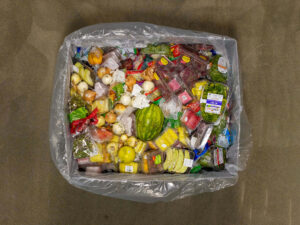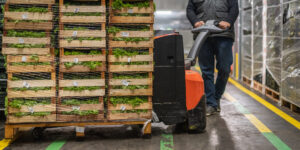June 6, 2024
In this article: Why Does So Much Food Go to Waste? | Key Business Drivers for Reducing Wasted Food | Sustainable Solutions to Wasted Food | Your Partner in Wasted Food Diversion
Summary: Recent reporting from the U.N. demonstrates the growing scale of the wasted food problem globally. In this post, we explore how and why food waste happens all along the supply chain, the business drivers and new technologies that are fueling new efforts to reduce wasted food, and sustainable pathways businesses should consider to reduce their wasted food volumes.
More than one billion meals are wasted around the world each day while nearly 800 million people go hungry, according to a recent U.N. report. Just within the U.S., it has been estimated that nearly 63 million tons of food goes to waste annually, or nearly 40% of the total food supply, according to a 2019 report from Barclays.
These astounding numbers lead to a big question: why does so much food go to waste, and how do we begin to tackle such a significant social problem? In this post, we’ll explore where and how food gets wasted along the food system and supply chain, the different sustainable pathways for reducing food waste, and the technology solutions that are enabling wasted food diversion at scale.
Why Does So Much Food Go To Waste?
There are several different streams of wasted food contributing to the problem today. According to a 2023 report from ReFED, the biggest single stream of wasted food comes from consumers, with household wasted food making up nearly 48% of all food waste in landfills, often due to:
- Buying more food than they need
- Confusion about expiration and sell-by dates
- Dated waste management infrastructure that does not offer service alternatives to prevent food waste from going to landfills, such as community composting or anaerobic digestion facilities.
The other ~52% of wasted food happens in several business sectors:
- Farming accounts for roughly 16.8% of wasted food, where environmental and market conditions, such as imperfections, pricing, and labor shortages can impact what gets harvested and sold — leading to food that would otherwise enter the market being discarded instead.
- Manufacturing makes up 14.7% of wasted food, and it can happen as a result of human and technological error, allergen cross-contamination issues, and experimentation of manufacturing new products to achieve the right quality and quantity.
- Consumer-facing businesses contribute 20.2% of wasted food, and there are several streams within this category that are distinct from each other:
- Retail grocers – In 2022, retailers generated 4.99M tons of surplus food, nearly 35% of which went to landfill or was incinerated as waste, according to ReFED. Some of this is the result of inefficient ordering systems and processes, as well as shifting consumer demand, which make it difficult for retail managers to know how much to order (or not order) of a type of food. Company culture and employee training around donation practices and food waste management can also play a role in wasted food volumes.
Food service settings can encompass many different consumer experiences — from restaurants to airports, to healthcare facilities, military institutions, and schools — each with their own challenges to food waste management. Of the 20% of total wasted food that consumer-facing businesses contribute, full service and limited service restaurants contribute 48%, or nearly 9 tons annually.
Dated Waste Management Infrastructure – Another key reason that food is wasted is because of dated waste management infrastructure and processes. Individual households and commercial businesses have not had access to many options to change the way they handle food waste or recyclable materials. While current waste management companies have built much of the infrastructure we have today and played an essential role in establishing our recycling systems, the volume of waste produced by a growing population has outpaced innovation. New infrastructure and processes are desperately needed to tackle waste management, if we want to reduce food insecurity and environmental harms.
Key Business Drivers for Preventing & Reducing Wasted Food
It’s clear from the statistics outlined above that business as usual leaves too much food waste behind, which not only exacerbates social problems like food insecurity, but contributes to climate change through harmful greenhouse gas emissions like methane.
New solutions are needed to help companies – from large corporations to independently owned local businesses – prevent and reduce wasted food. Today, there are a few key influences that are driving innovation in food waste management on a commercial and industrial scale:
Emerging Legislation – More than 3,000 publicly traded companies are subject to climate disclosures by the Securities & Exchange Commission, while more than 10,000 companies are subject to climate regulations in the state of California, which is leading the way on emerging legislation for organic waste management. These federal and state standards not only establish regulations to ensure that businesses are required to change how they manage their wasted food, but in some cases, they also open new opportunities for businesses to collaborate with different types of organic waste haulers than they were previously able to.
ESG Goals — Companies who have committed to environmental, social, and governance (ESG) criteria are seeking ways to reduce their Scope 3 emissions: indirect emissions that occur upstream and downstream of a company’s value chain, such as wasted food.
New technologies — You can’t manage what you don’t measure; technology and data are key drivers of creating sustainable change in how wasted food is managed. New technologies like Divert’s Radio Frequency Identification (RFID) tracking platform are providing unprecedented visibility into company operations, making it possible to track site-specific wasted food data to analyze how and why food items are wasted. With this new data, companies can identify opportunities and implement strategies to prevent and reduce their wasted food volumes, and report those improvements to their stakeholders.
Business costs — Wasted food also represents a cost that businesses have to pay twice: first in purchasing and handling that food, and then in paying to dispose of it. Reducing food and vegetable waste alone represents an $18 billion opportunity for retailers, according to Barclays.
Consumer awareness – The visible effects of climate change have ushered in a new level of consumer awareness around corporate practices that contribute to environmental harm, and consumers are making it clear in purchasing behavior, survey responses, and public discourse that they not only expect companies to improve their food recovery efforts and reduce their environmental impact, but they are willing to pay more for products and services from companies that are demonstrating environmental responsibility. Take this 2022 survey from restaurant software company Deliverect:
- 51% of survey respondents said seeing large amounts of food waste frustrates them and impacts their decision to order from that restaurant again
- 73% of respondents want more accurate portion sizes to avoid food waste
- 68% said takeaway restaurants should have practices in place to avoid unnecessary food waste
Sustainable Food Waste Management Solutions
Each of these business drivers are helping reduce the amount of organic waste that ends up in landfills, which is a step in the right direction. Yet, it’s not enough to simply keep organic waste out of the landfill. If businesses want to have a significant environmental impact, consideration needs to be given to where their material is being diverted and how it is being processed, because not all waste diversion methods are created equal.
Composting food waste is a great option for reducing organic waste on a smaller scale, like individual households or small residential programs, especially when that compost is used to support home gardens. But on a commercial or industrial scale, large volumes of organic waste make composting a challenge for two reasons: the high moisture content of the waste, and the de-packaging that has to be done to prevent contamination.
In 2023, the Environmental Protection Agency released their new Wasted Food Scale, which outlines prioritization of sustainable food waste pathways. A closer look at the EPA’s report makes it clear that stand-alone anaerobic digestion is the best approach to scale wasted food reduction at a commercial and industrial level because it scores high on purity and contamination reduction while focusing solely on nutrient-dense wasted food without incorporating green (yard) waste, human wastewater, or animal manure into its process. Anaerobic digestion also produces environmentally beneficial byproducts, such as biogas that can be fed into local power supplies to reduce reliance on fossil fuels, as well as beneficial digestate that can be used as an agricultural soil amendment.

Divert: Your Partner in Sustainable Wasted Food Diversion
At Divert, we believe that environmental sustainability is as good for business as it is for the planet. Our optimization program helps businesses prevent waste upstream and recover waste downstream to keep as much wasted food out of local landfills as possible.

Prevent
We invent transformative technologies and create actionable data to help our customers understand and prevent waste.

Provide
We take a people-first approach to food recovery and food rescue by providing our customers with data-driven solutions and support to optimize their food donations to communities in need.

Power
Our proprietary process removes greenhouse gasses from the food value chain by converting non-edible wasted food into renewable energy.
Our approach aligns with the EPA’s Wasted Food Scale with sustainable food waste pathways that prioritize prevention and donating to the food insecure before diverting inedible food to be put to its best and highest use in the form of renewable energy.
Divert has nearly 17 years of experience building and scaling responsible infrastructure to help our customers streamline wasted food diversion across the U.S. Discover more about our solutions and the positive impacts we’re creating with our clients.



